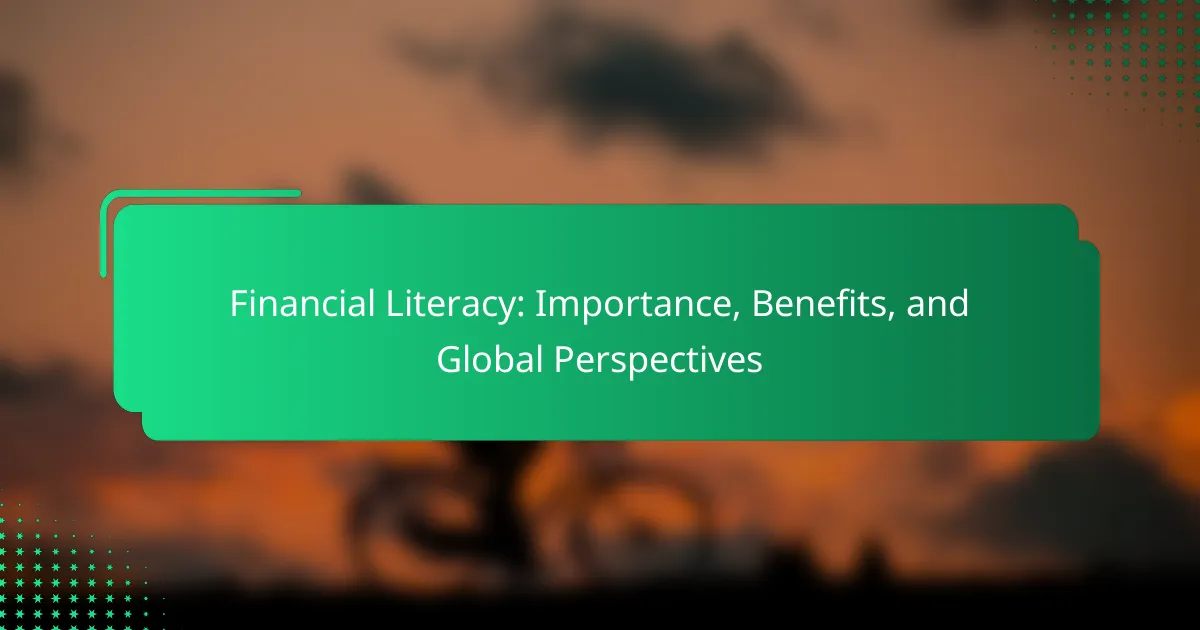Financial literacy is essential for making informed financial decisions and achieving economic stability. This article explores the importance of financial literacy, its benefits, and varying global perspectives. It highlights how improved budgeting, saving, and investing skills lead to reduced debt and increased wealth. Additionally, it examines the role of education in enhancing financial capability across different regions.

What is Financial Literacy?
Financial literacy is the ability to understand and effectively manage financial resources. It is crucial for making informed decisions about saving, investing, and budgeting. Improved financial literacy leads to better financial stability, reduced debt, and increased wealth accumulation. Globally, financial literacy varies, with some regions prioritizing education to enhance economic growth and individual well-being.
How does financial literacy impact personal finance management?
Financial literacy significantly enhances personal finance management by equipping individuals with essential skills to make informed financial decisions. It enables better budgeting, saving, and investment strategies. For instance, individuals with high financial literacy are more likely to save for retirement and avoid high-interest debt, leading to improved financial stability. Studies show that financial literacy can reduce the likelihood of financial distress, fostering long-term economic well-being.
What are the key components of financial literacy?
Key components of financial literacy include budgeting, saving, investing, credit management, and understanding financial products. Mastering these elements empowers individuals to make informed financial decisions. For example, effective budgeting helps track expenses and prioritize savings. Understanding credit management is crucial for maintaining a good credit score, which affects loan eligibility. Investing knowledge allows individuals to grow wealth over time. Each component plays a vital role in achieving financial stability and security.

Why is Financial Literacy Important?
Financial literacy is crucial for making informed financial decisions. It empowers individuals to manage their finances effectively, leading to improved economic stability and reduced debt levels. Studies show that financially literate individuals are more likely to save for retirement and invest wisely. Globally, financial literacy rates vary, with higher levels associated with better economic outcomes in various countries.
How does financial literacy influence economic empowerment?
Financial literacy significantly enhances economic empowerment by equipping individuals with the skills to make informed financial decisions. It fosters better budgeting, saving, and investing habits, leading to increased financial stability. Studies show that financially literate individuals are more likely to start businesses and invest in education, contributing to economic growth. Furthermore, communities with higher financial literacy rates often experience reduced poverty levels and improved overall economic health.
What role does financial literacy play in reducing debt?
Financial literacy significantly reduces debt by equipping individuals with knowledge and skills to manage finances effectively. Understanding budgeting, interest rates, and debt management strategies empowers people to make informed decisions. For instance, individuals with high financial literacy are 25% less likely to carry credit card debt, as they can prioritize payments and avoid high-interest traps. Additionally, financial education fosters confidence in negotiating repayment plans, further alleviating financial burdens.
How does financial literacy contribute to informed decision-making?
Financial literacy enhances informed decision-making by equipping individuals with the skills to analyze financial information. It fosters confidence in budgeting, investing, and understanding credit. As a result, financially literate individuals make better choices, leading to improved financial health and stability. Research shows that higher financial literacy correlates with increased savings rates and lower debt levels. This foundational knowledge is essential for navigating complex financial landscapes globally, ultimately contributing to economic resilience.

What are the Benefits of Financial Literacy?
Financial literacy empowers individuals to make informed financial decisions, enhancing their economic stability. Improved budgeting skills lead to better savings and reduced debt levels. Knowledge of investments can increase wealth accumulation over time. Additionally, financial literacy fosters confidence in navigating financial products and services, ultimately contributing to overall well-being.
How can financial literacy improve savings habits?
Financial literacy significantly enhances savings habits by equipping individuals with essential knowledge and skills. Improved understanding of budgeting, interest rates, and investment options fosters better financial decision-making. As a result, individuals become more adept at setting savings goals and prioritizing their financial health. Studies indicate that financially literate individuals are more likely to save consistently and effectively, leading to greater financial stability over time.
What impact does financial literacy have on investment choices?
Financial literacy significantly influences investment choices by enhancing decision-making. Individuals with strong financial literacy understand market trends, risk management, and investment strategies, leading to more informed choices. For instance, studies show that financially literate individuals are more likely to invest in stocks and diversify their portfolios, which can result in higher returns over time. Additionally, financial literacy fosters confidence in managing personal finances, encouraging proactive investment behaviors. This knowledge contributes to better financial outcomes and long-term wealth accumulation.
How does financial literacy promote financial security?
Financial literacy enhances financial security by equipping individuals with the skills to manage their finances effectively. This knowledge fosters informed decision-making, enabling better budgeting, saving, and investing. As a result, financially literate individuals are less vulnerable to economic shocks and can build wealth over time. Studies show that financial literacy is linked to higher savings rates and improved financial health, underscoring its critical role in promoting long-term financial security.

What are the Global Perspectives on Financial Literacy?
Financial literacy is essential for informed financial decision-making globally. It empowers individuals to manage money, invest wisely, and plan for retirement. Countries with high financial literacy rates often see improved economic stability and personal wealth. For instance, nations like Norway and Sweden prioritize financial education in schools, leading to higher financial capability among citizens. Conversely, regions with low financial literacy face challenges such as increased debt and financial insecurity. Addressing these disparities is crucial for fostering economic growth and resilience worldwide.
How does financial literacy vary across different cultures?
Financial literacy varies significantly across cultures due to differing educational systems, economic environments, and societal values. For example, countries with strong financial education programs, like Finland, show higher levels of financial literacy compared to those with limited resources, such as some developing nations. Cultural attitudes towards saving, investing, and debt also shape financial literacy. In collectivist societies, communal financial decision-making may prevail, while individualistic cultures often emphasize personal financial responsibility. This diversity highlights the need for tailored financial education that respects cultural contexts.
What initiatives are in place globally to enhance financial literacy?
Various global initiatives aim to enhance financial literacy, recognizing its vital role in economic stability. Programs like the OECD’s Financial Literacy Framework promote education through guidelines and resources. The World Bank’s Global Financial Literacy Program supports local initiatives worldwide. National campaigns, such as those in the U.S. and the UK, focus on improving personal finance skills, targeting diverse populations. Collaborative efforts between governments, NGOs, and private sectors drive these initiatives, fostering a financially informed society.

What are the Universal Attributes of Financial Literacy?
Financial literacy encompasses essential skills like budgeting, saving, investing, and understanding financial products. These universal attributes empower individuals to make informed financial decisions, enhancing their economic stability and well-being. Financial literacy promotes better money management, reduces debt, and fosters wealth accumulation. Globally, it varies in implementation and importance, reflecting diverse economic contexts and educational approaches.
How do financial literacy programs typically operate?
Financial literacy programs typically operate through structured curricula that teach essential financial skills. They often include workshops, online courses, and community outreach initiatives. These programs aim to enhance participants’ understanding of budgeting, saving, investing, and managing debt, ultimately promoting financial well-being. Many programs also incorporate real-life scenarios and practical exercises to reinforce learning. Additionally, they may involve partnerships with local organizations to reach diverse populations and address specific community needs, thereby expanding their impact.

What are Unique Attributes of Financial Literacy?
Unique attributes of financial literacy include critical thinking, adaptability to changing economic conditions, and effective communication skills. These traits empower individuals to make informed financial decisions and navigate complex financial landscapes. Additionally, financial literacy fosters a sense of confidence and independence in managing personal finances. As a result, individuals with high financial literacy are better equipped to plan for retirement, invest wisely, and avoid financial pitfalls.
What distinguishes financial literacy in developed versus developing countries?
Financial literacy in developed countries often emphasizes investment strategies and wealth management, while in developing countries, it focuses on basic budgeting and saving skills. Developed nations typically have greater access to financial education resources, leading to a deeper understanding of complex financial products. In contrast, developing countries may lack these resources, resulting in lower financial knowledge and skills. Additionally, cultural factors influence financial practices, with developed nations tending to prioritize long-term financial planning, whereas developing countries may focus on immediate financial needs. This disparity highlights the unique attributes of financial literacy shaped by economic contexts.

What are Rare Attributes of Financial Literacy?
Rare attributes of financial literacy include the ability to navigate complex financial systems, adapt to changing economic environments, and understand behavioral finance. These traits enhance decision-making and promote long-term financial well-being. Additionally, a unique attribute is the capacity to critically evaluate financial products, which is not commonly possessed by all individuals.
What innovative methods are used to teach financial literacy?
Innovative methods to teach financial literacy include gamification, interactive simulations, and real-world projects. Gamification engages learners through game-like elements, enhancing motivation. Interactive simulations provide hands-on experience with financial decision-making. Real-world projects connect theory to practice, fostering practical understanding. These methods address diverse learning styles and increase retention.
What uncommon challenges do individuals face in achieving financial literacy?
Individuals face several uncommon challenges in achieving financial literacy, including cultural barriers, emotional factors, and access to resources. Cultural norms may discourage open discussions about money, leading to a lack of understanding. Emotional factors, such as anxiety or shame about financial situations, can hinder learning. Additionally, limited access to quality educational resources creates disparities in financial knowledge. These challenges collectively impact the ability to make informed financial decisions, highlighting the need for targeted educational initiatives.

How can Financial Literacy be Improved?
Financial literacy can be improved through education, practical experience, and community programs. Enhancing knowledge about budgeting, saving, and investing empowers individuals to make informed financial decisions. Schools and organizations can implement workshops and courses that focus on real-world applications. As a result, increased financial literacy leads to better economic stability and personal growth.
What best practices can enhance financial literacy education?
Incorporating best practices can significantly enhance financial literacy education. Engaging teaching methods, such as interactive workshops and real-life simulations, promote active learning. Tailoring content to diverse audiences ensures relevance, while integrating technology, like apps and online resources, increases accessibility. Continuous assessment and feedback mechanisms help measure progress and adjust strategies effectively.
What common mistakes should be avoided in financial literacy programs?
Common mistakes in financial literacy programs include lack of engagement, oversimplification, neglecting diverse learning styles, and insufficient real-life application. Engaging participants through interactive methods is crucial for retention. Oversimplifying complex financial concepts can lead to misunderstandings. Programs must cater to various learning preferences to be effective. Lastly, applying knowledge to real-life scenarios enhances the practical value of financial literacy.
How can technology support financial literacy initiatives?
Technology supports financial literacy initiatives by providing accessible resources, interactive tools, and personalized learning experiences. Digital platforms enable users to engage with financial concepts through apps and online courses. For example, gamification in financial education apps enhances user engagement and retention. Data analytics allows organizations to tailor educational content to specific demographics, improving effectiveness. Additionally, online communities foster peer learning and support, creating a collaborative environment for financial growth.


